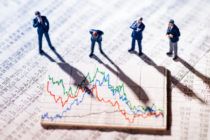But, while 2015 has indeed been a rather wild ride across the globe, one can’t escape the feeling that when it comes to the US, the wildest part has yet to come. While the S&P 500 was down around 0.5% for the year, it is up around 182% from its lows in March 2009, a move driven predominantly by masses of quantitative easing and near zero-interest rates. And, now that the Fed has finally made its first interest rate move, all eyes are on what will happen next.
There are a number of people concerned that a new US recession is around the corner, but many remain rather positive on the prospects for the US economy, although Monday’s announcement of a second consecutive US PMI reading below 50 has put something of a dampener on expectations of the timing of the next hike by the Federal Reserve.
Indeed, there remain a number of question marks around exactly how or, indeed, whether, the US will be able to transition from seven years of zero interest rates to a more ‘normal’ cycle, whether the strong dollar will prove too much of a burden for the manufacturing sector, or if, in fact, the Fed has waited far too long to start its hiking cycle.
However, for investors, it is important to make a distinction between the US economy and the US stock market.
John Bilton, global head of multi-asset strategy at J.P. Morgan Asset Management, said the firm viewed 2015 as an important year in the evolution of what it expects will become “the longest period of U.S. economic expansion in history”. It’s hard to be more bullish than him, since the longest record of U.S. GDP growth in modern times spanned 15 years, from 1959 through the golden 1960s all the way until the oil crisis hit in 1974. We are only six years into the current GDP growth cycle, which started in 2010.
“While it is true that we may have “borrowed” some returns from the future, we would not bet against further, modest upside to U.S. equities in the next couple of years given the broad-based strength of the U.S. consumer,” he said.







